#Spodoptera litura
Text

on the topic of favourite moths, here's an Oriental Leafworm who spent the day on our front door. at a glance they seem inconspicuous, but a closer look reveals incredible beauty.
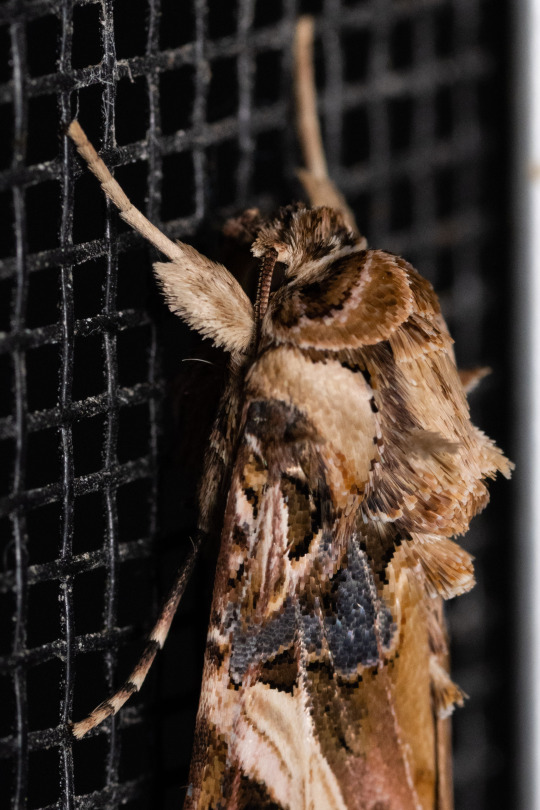
Oriental Leafworm Moth, male (Spodoptera litura).
#ljsbugblog#bugblr#entomology#macro#insects#lepidoptera#moths#noctuidae#spodoptera#armyworm moths#spodoptera litura#oriental leafworm moth
76 notes
·
View notes
Text
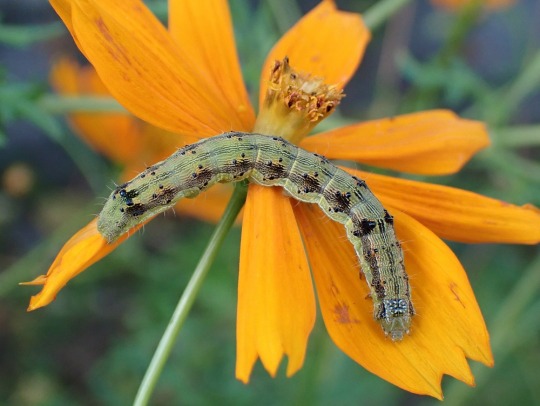
キバナコスモスにいたハスモンヨトウ(11月16日)
#芋活
tobacco cutworm or cotton leafworm (Spodoptera litura)
#芋活#tobacco cutworm#cotton leafworm#Spodoptera litura#worm#insects#owady#bugs#gąsienica#japan#flowers#kwiaty
14 notes
·
View notes
Text
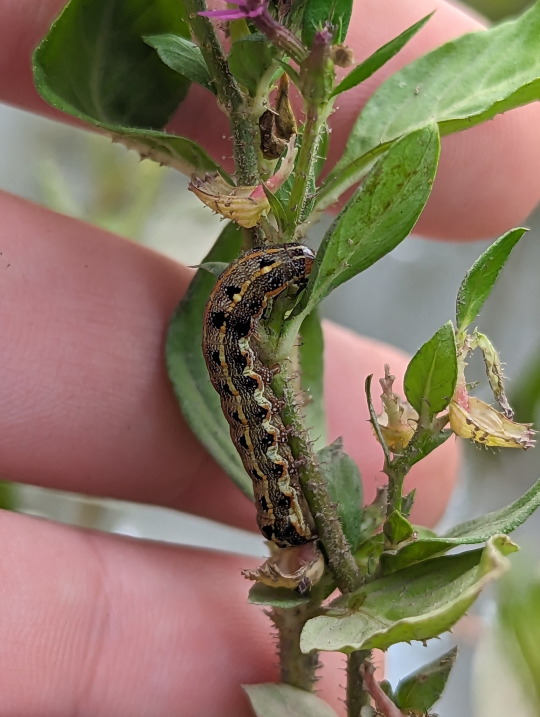
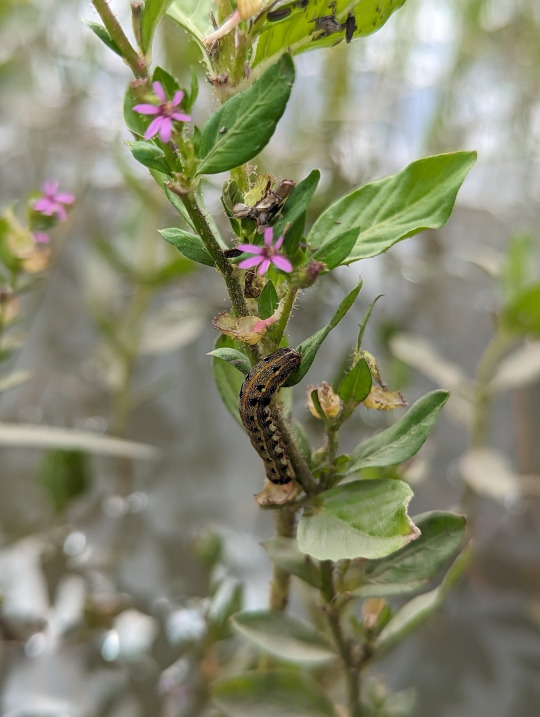
Photos 1-2 - Specimen 1


Photos 3-4 - Specimen 2
Even when it floods, the caterpillars find a way!
24/09/23 - Spodoptera litura / hostplant - Cuphea carthagenensis
QLD:WET - El Arish, farmland
#invertblr#invertebrates#Arthropods#Arthropoda#insects#insecta#insectblr#insects tw#bugs#bugblr#bugs tw#bug#insect#entomology#Cuphea carthagenensis#Spodoptera litura#Oriental Leafworm Moth#Noctuidae#Noctuoidea#lepidoptera#lepidopterology#caterpillars#larvae#larval stage
9 notes
·
View notes
Text
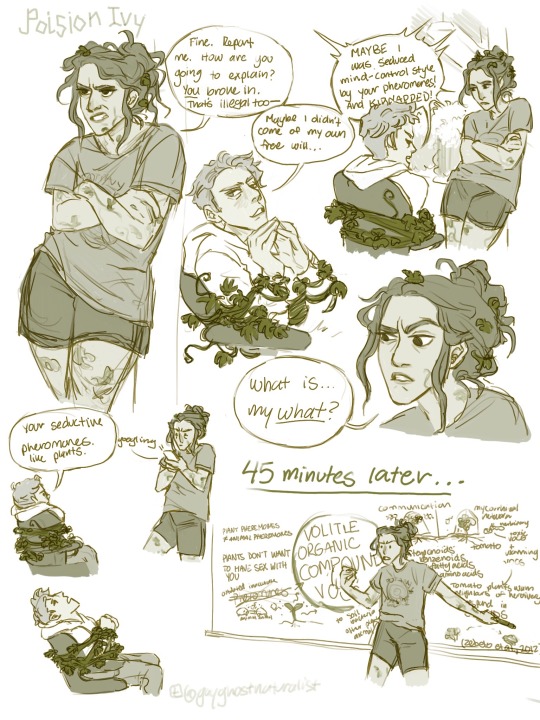
My favorite part is when they put intact leaves and the caterpillars in a faraday cage (YEAH) still sealed up, but with airflow to a non-wounded plant, which then produced chemical defenses (VOCs) as if it was being chewed. Those VOCs are different than those produced by mechanically damaged plants too! This process can start in seconds, which is amazing! (https://doi.org/10.1016/j.plantsci.2012.08.006)
They’re referred to as Volatile Organic Compounds (VOCs) and this is one way plants communicate, from cells to forests. The first time I learned this in botany I’m pretty sure it was Zebelo et al., they put tomato plants in gas-controlled chambers and fed filtered air in, took out samples and leaves. They had a species of caterpillar (Spodoptera litura) eat some of the plants, and identified the VOCs they produced, a control group, and a group that was mechanically damaged (“chewed”).
The other experiment we talked about was Song et al. (2010), which showed that VOCs traveled through mycorrhizal networks (fungal networks, usually Glomeromycetes)! (https://doi.org/10.1016/j.plantsci.2012.08.006)
…So could you say Poison Ivy has seductive pheromones?

But idk! I don’t think it’s that simple! Are the humans targeted as pollinators? Sex pheromones are ideally between members of the same species so I might call BS if her “plant powers” are the cause, unless they have a specific function. The only comparison I can think of off the top of my head is how some orchid flowers looked like bees? Idk any botanists are welcome to derail this, flowering plants are not my forte. I feel like flirting is/would be enough.
#poison ivy but she’s an actual botanist#VOCs#poison ivy dc#poison ivy art#poison ivy comic#poison ivy#pamela isley#poison ivy fanart#science fiction#art#illustration#artists on tumblr#character design#comic#dc#dc comic#dc fanart
184 notes
·
View notes
Text
Les plantes communiquent entre elles et peuvent se prévenir en cas de danger
See on Scoop.it - EntomoNews
Grâce à ce signalement, les plantes voisines peuvent mettent en place leurs propres défenses pour se protéger.
Courrier international
Publié hier à 06h00
"Les arbres d’une forêt peuvent communiquer entre eux et se prévenir mutuellement d’un danger, selon une étude parue mardi dans la revue Nature, dont le Washington Post relaie les résultats samedi 21 octobre.
Il en ressort que les plantes blessées émettent certains composés chimiques qui peuvent s’infiltrer dans les tissus internes d’une plante saine et activer les défenses à l’intérieur de ses cellules. Et grâce à ce signalement, écrit le journal, “les arbres voisins mettent en place leurs propres défenses” et “la forêt est sauvée”.
Pour tester la communication entre les plantes, les scientifiques “ont écrasé manuellement des feuilles et placé des chenilles sur des plants de moutarde Arabidopsis ou de tomate afin de déclencher l’émission de divers volatiles de feuilles vertes, explique le Washington Post. Puis ils ont “répandu les émanations individuelles sur des plantes saines pour voir si elles réagissaient”.
C’est la première fois que des chercheurs parviennent à “visualiser la communication entre plantes”, s’enthousiasme Masatsugu Toyota, auteur principal de l’étude."
(...)
-------
NDÉ
L'étude
Green leaf volatile sensory calcium transduction in Arabidopsis | Nature Communications, 17.10.2023 https://www.nature.com/articles/s41467-023-41589-9
We used Arabidopsis accession No-0 and tomato as emitter plants because they emit various VOCs, including GLVs, in response to wounding29,32,33. First, we monitored [Ca2+]cyt increases in Arabidopsis (receiver) following exposure to VOCs emitted from Arabidopsis plants (source of VOCs) fed on by the common cutworm (Spodoptera litura)
[Image] Exposure to VOCs emitted by leaves consumed by the herbivore S. litura induces [Ca2+]cyt increases in receiver Arabidopsis leaves.
The experimental setup for Ca2+ imaging in Arabidopsis (receiver) upon exposure to VOCs emitted by leaves consumed by S. litura larvae is schematically illustrated. Prior to the experiment, the receiver Arabidopsis in a plastic dish was acclimated by directing airflow from an empty plastic bottle for 10 min, allowing its adaptation to the experimental conditions. Subsequently, receiver Arabidopsis was exposed to VOCs emitted from a plastic bottle containing S. litura larvae and either Arabidopsis or tomato leaves (source of VOCs) by connecting the bottle and manipulating the valve. The black arrows indicate the direction of airflow.
0 notes
Text
Spodoptera litura, otherwise known as the tobacco cutworm or cotton leafworm, is a nocturnal moth in the family Noctuidae. S. litura is a serious polyphagous pest in Asia, Oceania, and the Indian subcontinent that was first described by Johan Christian Fabricius in 1775. Its common names reference two of the most frequent host plants of the moth. In total, 87 species of host plants that are infested by S. litura are of economic importance. The species parasitize the plants through the larvae vigorous eating patterns, oftentimes leaving the leaves completely destroyed. The moth's effects are quite disastrous, destroying economically important agricultural crops and decreasing yield in some plants completely. Their potential impact on the many different cultivated crops, and subsequently the local agricultural economy, has led to serious efforts to control the pests.
(-36.718319,174.720025)
22 Northcross Drive, Oteha, Auckland 0632
0 notes
Text
ដង្កូវហ្វូង
ឈ្មោះទូទៅជាភាសាខ្មែរ: ដង្កូវហ្វូង
ឈ្មោះទូទៅជាភាសាអង់គ្លេស: Armyworm
ឈ្មោះវិទ្យាសាស្ត្រ: Spodoptera exigua និង S. litura
គ្រួសារ: Noctuidae
ការពិពណ៌នា
ពង: ពងជាចង្កោម និងរុំដោយស្រកាខ្លួនពណ៌ត្នោត ។
មិនទាន់ពេញវ័យ: កូនដង្កូវមានពណ៌បៃតងស្លេក និងឡើងពណ៌ប្រផេះទៅពណ៌ត្នោតចាស់នៅពេលដែលវាធំ ។ អេសអិល មានត្រីកោណពណ៌ខ្មៅពីរជួរ និងខ្សែពណ៌លឿង…

View On WordPress
0 notes
Text

MOTH UNIVERSAL TRAP
Contains components: Insect root collection, insect collection bag, lure core support rod
Color: green, red, blue, yellow
Material: plastic
Can be used with lure core: Spodoptera litura lures, beet moth lures and other noctuid lures
Application range: Vegetable gardens, greenhouses, courtyards, fields, orchards, etc.
Trapable: Spodoptera litura, beet armyworm, cotton bollworm, tobacco caterpillar, etc.
Specifications: Overall length: 25cm Diameter: 11.8cm
Precautions: Do not trap and kill insects alone, use in combination with the lure
1 note
·
View note
Text
Budidaya kacang tanah di desa pematang seleng
Oktober 25, 2021

TEKNIK BUDIDAYA Kacang Tanah
Benih
• Benih yang digunakan berasal dari tanaman sehat, bebas hama dan penyakit, kualitas bijinya baik, mempunyai hasil tinggi dan berumur genjah.
• Varietas unggul kacang tanah yang telah dilepas oleh Badan Litbang pertanian adalah: Gajah, Kelinci, Zebra, Kidang, Rusa, Anoa, Tapir, Pelanduk, Kancil, dan Domba.
PENGOLAHAN TANAH DAN PERSIAPAN TANAM
• Tanah diolah dengan membersihkan lahan terlebih dahulu kemudian dibajak dan digaru sedalam 20 – 30 cm.
• Buat petakan dan saluran antar-petak (saluran drainase) dengan jarak 3-4 m. Lebar saluran 25-30 cm, tinggi saluran petakan 20-30 cm.
• Buat bedengan dengan jarak tanam 40 x 10 cm.
PENANAMAN
• Benih ditanam pada lubang dengan kedalaman 3-5 cm dengan cara tugal, 1 benih/lubang.
• Jumlah benih yang dibutuhkan sekitar 80 kg biji/ha.
PENYIANGAN
• Penyiangan dilakukan minimal 2 kali selama pertumbuhan tanaman yaitu pada saat tanaman berumur 21 hari setelah tanam (HST) dan umur 40 HST.
• Saat penyiangan kedua tanah digemburkan dan ditimbun dekat pangkal batang tanaman agar bakal buah mudah menembus tanah sehingga pertumbuhannya optimal.
PENGAIRAN
• Tanaman kacang tanah tidak menghendaki tanah yang tegenang.
• Waktu pengairan yang baik adalah pagi atau sore hingga tanah cukup basah.
PENGENDALIAN HAMA DAN PENYAKIT
• Pengendalian hama dan penyakit menggunakan prinsip pengendalian hama terpadu (PHT).
• Jenis hama yang menyerang pada tanaman kacang tanah adalah :
1. Uret Gejala: memakan akar, batang bagian bawah dan polong. Akhirnya tanaman layu dan mati. Pengendalian: olah tanah dengan baik, penggunaan pupuk kandang yang sudah matang, menanam serempak, penyiangan intensif, jika tanaman terlanjur mati segera dicabut dan uret dimusnahkan.
2. Ulat Penggulung Daun Gejala: daun terlipat menguning, akhirnya mengering. Pengendalian: penyemprotan menggunakan Pestona.
3. Ulat Grayak (Spodoptera litura) Ulat memakan epidermis daun dan tulang secara berkelompok. Pengendalian: bersihkan gulma, menanam serentak, pergiliran tanaman, penyemprotan menggunakan Natural Vitura.
4. Ulat Jengkal (Plusia sp) Ulat menyerang daun kacang tanah. Pengendalian:penyemprotan menggunakan Pestona.
5. Kumbang Daun Gejala: daun tampak berlubang, daun tinggal tulang, juga makan pucuk bunga. Pengendalian: penanaman serentak; penyemprotan menggunakan Pestona.
6. Wereng Empoasca Hama yang penting bagi tanaman kacang tanah adalah hama Empoasca. Hama ini tidak terlalu merugikan bagi tanaman kacang tanah.
7. Hama lainnya adalah Aphis dan tungau yang menjadi vektor (pembawa) virus.
• Penyakit yang sering menyerang kacang tanah :
1. Layu Bakteri (Xanthomonas solanacearum ) Gejala : saat matahari terik tanaman terkulai seperti disiram air panas, dan langsung mati.
2. Bercak Daun (Cercospora personata) disebabkan oleh jamur.
3. Penyakit Selerotium
PANEN
Setelah Semua siap panen, panen kacang tersebut dengan menarik atau mencabut batang atau tanaman kacang tanah tersebut.
Sekian Budidaya kacang tanah, smoga bermanfaat untuk kita semua.
Salam KKN desan pemsel 2021
Universitas Labuhan Batu
2 notes
·
View notes
Photo

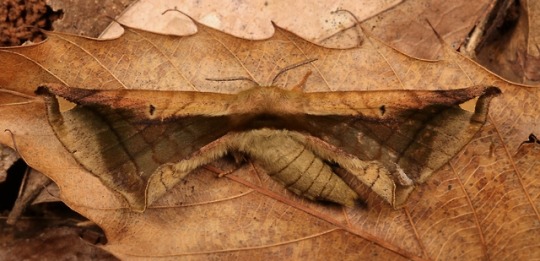
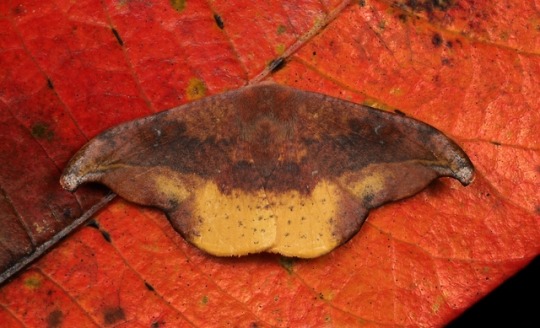

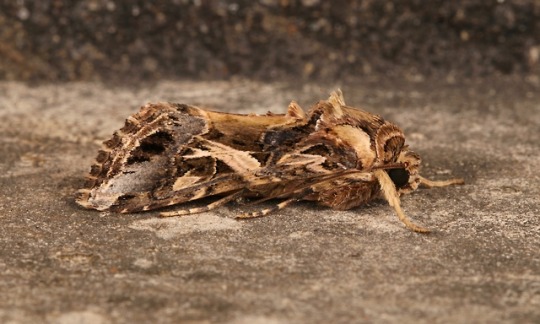
MOTHS from Yunnan, China
Click on and scroll through images for individual IDs…..
by Sinobug (itchydogimages) on Flickr.
Pu’er, Yunnan, China
See more Chinese moths on my Flickr site HERE...
166 notes
·
View notes
Photo

ハスモンヨトウ、Spodoptera litura、11月18日、名古屋市
13 notes
·
View notes
Text
Des rayons laser contre un ravageur de cultures : la découverte de chercheurs japonais | Nippon.com – Infos sur le Japon
See on Scoop.it - EntomoNews
Une équipe de l’Institut national de l’ingénierie du laser, situé à Osaka, a découvert le moyen de se débarrasser d’un papillon de nuit ravageur de cultures, la noctuelle rayée (Spodoptera litura), en visant deux points vitaux avec un rayon laser.
Tout sur le Japon
Science Environnement 20/01/2023
"Cela ouvre la voie à de nouvelles méthodes pour éliminer les insectes sans utiliser de produits chimiques.
La noctuelle rayée, qui se retrouve un peu partout dans le monde et qui est désignée comme « nuisible » par le ministère de l’Agriculture, des Forêts et de la Pêche, détruit des plantes comme le soja, la betterave et le chou.
Si le rayon laser est déjà employé aux États-Unis pour tuer les moustiques, cette technologie est difficilement utilisable contre de plus gros insectes tels que les papillons de nuit.
Les chercheurs japonais ont cependant découvert que le « thorax » et le « visage » de la noctuelle rayée étaient vulnérables à la chaleur du laser. Un coup de rayon bien ciblé permettait de l’éliminer."
-------
NDÉ
Illustration
via Osaka Team Opens Way to Stamp Out Pest Moth with Laser Beam | 時事通信ニュース https://sp.m.jiji.com/english/show/24235
Traduction
Osaka, 19 janvier (Jiji Press) - Une équipe de l'Université d'Osaka a découvert des points vitaux d'un papillon de nuit nuisible vulnérables à un faisceau laser, ouvrant ainsi la voie à son éradication sans utiliser de produit chimique agricole.
L'équipe de l'Institut d'ingénierie laser de l'université nationale a fait cette découverte avec le Spodoptera litura, présent dans de nombreuses régions du monde, selon une étude annoncée lors d'une conférence universitaire jeudi.
Il existe une technologie développée aux États-Unis pour abattre les moustiques à l'aide d'un faisceau laser, qui génère de la chaleur. Mais il est difficile de se débarrasser de plus gros insectes comme les papillons de nuit avec cette technologie.
La Spodoptera litura est désignée comme un organisme nuisible par le ministère de l'agriculture. Sa chenille, connue sous le nom de ver gris du tabac, s'attaque aux cultures telles que les choux.
L'équipe a découvert que la poitrine et le visage du papillon sont des points vitaux. Elle a réussi à suivre les papillons volants de l'espèce et à les abattre en tirant sur eux des rayons laser.
Traduit avec www.DeepL.com/Translator (version gratuite)
Pour en savoir plus
New Tech that Zaps Agricultural Pests with Laser Beams » Japan 2 Earth https://featured.japan-forward.com/japan2earth/2022/01/131/
0 notes
Text
ALAMI! CALL! 0812-2558-1198, HARGA agen hayati insektisida agam, AGEN insektisida hayati Kalimantan Barat, insektisida hayati Ketapang
klik https://wa.me/6281225581198, DISTRIBUTOR insektisida Ketapang, AGEN agen hayati pengendali hama Kapuas Hulu, harga insektisida Sintang, insektisida bahan aktif Kalimantan Selatan, insektisida untuk apa, insektisida bubuk, insektisida bubuk, insektisida untuk bawang merah, insektisida cair, harga insektisida cair, insektisida dan hama sasaran
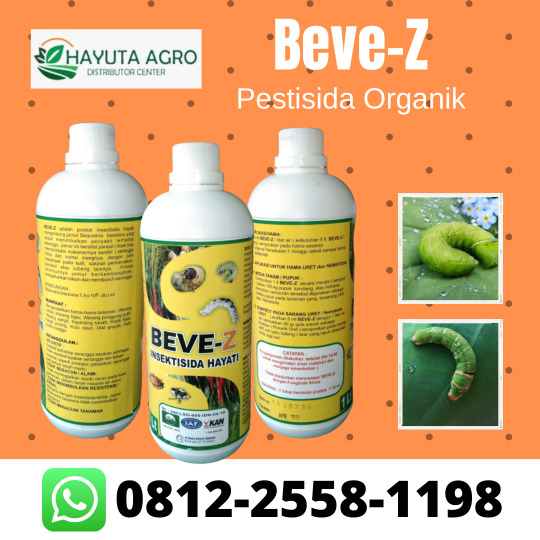
TOKO agen hayati pengendali hama Sintang, SUPPLIER harga insektisida Kalimantan Selatan, insektisida bahan aktif Banjar, insektisida untuk apa Kotabaru, insektisida bubuk, insektisida untuk bawang merah, insektisida untuk bawang merah, insektisida cair, harga insektisida cair, insektisida dan hama sasaran, insektisida
Beve Z Insektisida Hayati, Pupuk Insektisida Hayati Beve-Z Beuvaria Bassiana
Beve-Z adalah insektisida hayati mengandung cendawan Beuvaria bassiana yang ramah lingkungan dapat mengendalikan hama-hama serangga perusak tanaman dengan efektif dan ekonomis. Beve-Z aman untuk manusia, hewan serta tidak menimbulkan resistan/ kebal terhadap hama serangga/ insekta.
Bahan aktif: Beuvaria bassiana.
Sasaran hama: wereng (Nephotettix sp, Sogatella sp), walang sangit (Leptocorixa accuta), penggerek batang (Tryporhiza sp, Chilo supressalis) , Trips sp, Aphis sp, tungau, Plutella xylostella, Myzus sp, Penggerek buah coklat (PBK), Spodoptera litura, Bemesia tabaci.
Cara kerja Beve-Z
1. Menginfeksi mulut hama kemudian masuk merusak pencernaan.
2. Menempel di kulit mengeluarkan racun kemudian menghancurkan kulit.
3. Hama yang sudah terinfeksi ditumbuhi cendawan Beuvaria bassiana bila bersentuhan dengan hama serangga lain insyaAllah akan menular. Atau bila hama yang terinfeksi tertiup angin, berpotensi menulari hama yang lain.
4. Kematian hama setelah terinfeksi adalah 4 -8 hari.
INFO PEMESANAN :
HP : 0812-2558-1198
WA : 0812-2558-1198 / https://wa.me/6281225581198
0 notes
Text
HARGA KHUSUS! CALL! 0812-2558-1198, SUPPLIER agen hayati pengendali hama Medan, PUSAT harga insektisida Jawa Tengah, insektisida bahan aktif Cilacap
klik https://wa.me/6281225581198, AGEN agen hayati pengendali hama Kapuas Hulu, TOKO harga insektisida Sintang, insektisida bahan aktif Kalimantan Selatan, insektisida untuk apa Banjar, insektisida bubuk, insektisida untuk bawang merah, insektisida untuk bawang merah, insektisida cair, harga insektisida cair, insektisida dan hama sasaran, insektisida
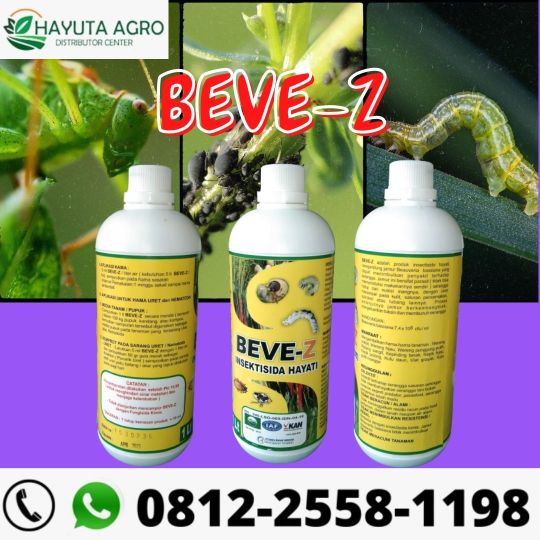
Beve Z Insektisida Hayati, Pupuk Insektisida Hayati Beve-Z Beuvaria Bassiana
Beve-Z adalah insektisida hayati mengandung cendawan Beuvaria bassiana yang ramah lingkungan dapat mengendalikan hama-hama serangga perusak tanaman dengan efektif dan ekonomis. Beve-Z aman untuk manusia, hewan serta tidak menimbulkan resistan/ kebal terhadap hama serangga/ insekta.
Bahan aktif: Beuvaria bassiana.
Sasaran hama: wereng (Nephotettix sp, Sogatella sp), walang sangit (Leptocorixa accuta), penggerek batang (Tryporhiza sp, Chilo supressalis) , Trips sp, Aphis sp, tungau, Plutella xylostella, Myzus sp, Penggerek buah coklat (PBK), Spodoptera litura, Bemesia tabaci.
Cara kerja Beve-Z
1. Menginfeksi mulut hama kemudian masuk merusak pencernaan.
2. Menempel di kulit mengeluarkan racun kemudian menghancurkan kulit.
3. Hama yang sudah terinfeksi ditumbuhi cendawan Beuvaria bassiana bila bersentuhan dengan hama serangga lain insyaAllah akan menular. Atau bila hama yang terinfeksi tertiup angin, berpotensi menulari hama yang lain.
4. Kematian hama setelah terinfeksi adalah 4 -8 hari.
INFO PEMESANAN :
HP : 0812-2558-1198
WA : 0812-2558-1198 / https://wa.me/6281225581198
JUAL insektisida untuk apa Kotabaru, GROSIR insektisida bubuk Banjarmasin, insektisida untuk bawang merah Sumatra Utara, insektisida cair Deli Serdang, harga insektisida cair, insektisida dan hama sasaran, insektisida dan hama sasaran, insektisida, insektisida sachet, insektisida putih, insektisida 0.5 gr
0 notes
Text
ALAMI! CALL! 0812-2558-1198, HARGA insektisida lalat buah paling ampuh agam, AGEN insektisida untuk cabe keriting Kalimantan Barat, insektisida untuk kutu putih Ketapang
klik https://wa.me/6281225581198, DISTRIBUTOR insektisida Ketapang, AGEN agen hayati pengendali hama Kapuas Hulu, harga insektisida Sintang, insektisida bahan aktif Kalimantan Selatan, insektisida untuk apa, insektisida bubuk, insektisida bubuk, insektisida untuk bawang merah, insektisida cair, harga insektisida cair, insektisida dan hama sasaran
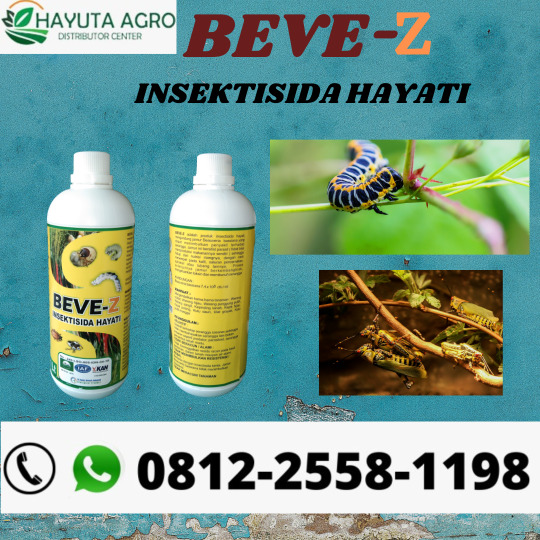
Beve Z Insektisida Hayati, Pupuk Insektisida Hayati Beve-Z Beuvaria Bassiana
Beve-Z adalah insektisida hayati mengandung cendawan Beuvaria bassiana yang ramah lingkungan dapat mengendalikan hama-hama serangga perusak tanaman dengan efektif dan ekonomis. Beve-Z aman untuk manusia, hewan serta tidak menimbulkan resistan/ kebal terhadap hama serangga/ insekta.
Bahan aktif: Beuvaria bassiana.
Sasaran hama: wereng (Nephotettix sp, Sogatella sp), walang sangit (Leptocorixa accuta), penggerek batang (Tryporhiza sp, Chilo supressalis) , Trips sp, Aphis sp, tungau, Plutella xylostella, Myzus sp, Penggerek buah coklat (PBK), Spodoptera litura, Bemesia tabaci.
Cara kerja Beve-Z
1. Menginfeksi mulut hama kemudian masuk merusak pencernaan.
2. Menempel di kulit mengeluarkan racun kemudian menghancurkan kulit.
3. Hama yang sudah terinfeksi ditumbuhi cendawan Beuvaria bassiana bila bersentuhan dengan hama serangga lain insyaAllah akan menular. Atau bila hama yang terinfeksi tertiup angin, berpotensi menulari hama yang lain.
4. Kematian hama setelah terinfeksi adalah 4 -8 hari.
INFO PEMESANAN :
HP : 0812-2558-1198
WA : 0812-2558-1198 / https://wa.me/6281225581198
TOKO agen hayati pengendali hama Sintang, SUPPLIER harga insektisida Kalimantan Selatan, insektisida bahan aktif Banjar, insektisida untuk apa Kotabaru, insektisida bubuk, insektisida untuk bawang merah, insektisida untuk bawang merah, insektisida cair, harga insektisida cair, insektisida dan hama sasaran, insektisida
#pupuk organik#pestisida hayati#penstisidauntukhamawareng#pupuk pestisida organik#pupuk pestisida terbaik
0 notes